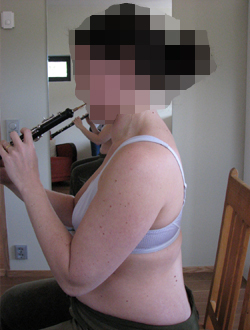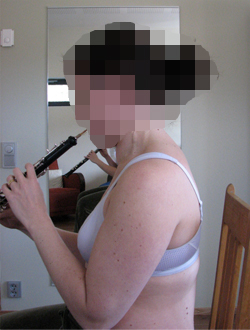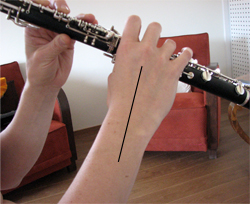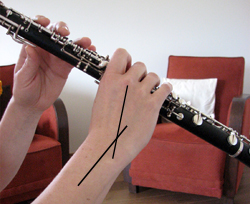Oboe - harjoittelu
Oboe
The body's centre position is the basic position to which the musician always returns. In the centre position, the spine maintains its natural curves. Spinal curves vary between individuals; in the centre position, the backs and hips of different people may look different.
In order to find the correct posture, the musicians should first examine the position of their pelvis. The pelvic centre position can be found, for example, by first pushing the pelvis as far in and out as possible. The centre position provides optimal mobility of the pelvis and good control of the deep abdominal muscles. Furthermore, when the pelvis is in the centre position, the thoracic spine and the rib cage also stay in the centre position more easily; this enables free and well-supported breathing. The centre position of the thoracic spine can also be found through extreme positions. When the thoracic spine and the rib cage are in the centre position, breathing is easy, the breastbone is in a vertical position and the back extensors are engaged but not tense. The rib cage/thoracic spine and the pelvis should be aligned when viewed from the side. The centre position of the head and neck can be found by first moving the head back and forward, then leaving it in the centre position where there is free movement between the skull and the cervical spine.
For oboists, a typical faulty position involves curving the thoracic spine and tilting it backward, causing the head to push forward.
|
The pelvis and the spine are in the centre position; the shoulder blades are supported against the rib cage. |
The pelvis tilts back, the head pushes forward, the shoulder blades tilt forward with the rib cage. |
Once the correct centre positions have been found, the shoulder blades can be examined next. The shoulder blades should be in a vertical position against the ribs, encouraging a natural position of the shoulders. A typical faulty position for oboists involves dropping and tilting the shoulder blade forward, especially the right-hand side shoulder blade which supports the instrument.
A correct position of the thoracic spine and the rib cage enables optimal muscular support for the shoulder blades. In turn, these muscles ensure relaxed and strong arm movement. The shoulder blades should be in a vertical position against the ribs, encouraging a natural position of the shoulders.
If the shoulder blade tilts forward and/or wings off, the shoulder blades have insufficient muscular support, causing strain in the neck and shoulder area and the upper limbs. This posture fault is more common in the right-hand shoulder blade, as the right arm is the one supporting the instrument. Because the movement of the shoulder blade can be difficult to understand, musicians usually need professional help in order to learn to engage the shoulder blade support muscles and to correct the shoulder blade position.
Wrists should remain slightly extended; 15 degrees up and 15 degrees tilted towards the little finger. This ensures free finger movement and optimal action of the deep muscles that support the hand. Good muscular support keeps the thumb arched and away from the palm, sufficiently open and under the hand. Good muscular support of the thumb is particularly important for the right hand, as the instrument is supported by these muscles. The thumb muscles start from the palm-side, near the wrist, extending over the base and middle joints of the thumb. For oboists, a faulty thumb position affects the movement of the ring finger and the little finger and increases strain in the thumb extensors, abductors and forearm muscles.
|
The wrist is in the centre position, the thumb is open and sufficiently under the hand, allowing the fingers to move freely. |
The wrist tilts too far towards the thumb. The thumb is too close to the hand, and the middle joint is overextended. |
Hand and wrist positions should be adjusted very carefully. Any changes should be supported by suitable hand exercises.




